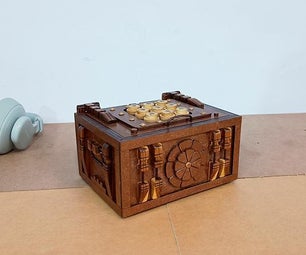Introduction: Patience Clock
They say that patience is a virtue. That's what this clock is all about. We check the time frequently throughout the day because we need to be somewhere, or we're running late, or we want to see how long we've been doing something. I wanted to make a clock that reminds me to be patient throughout the day.
The symbol on the clock is a Kanji character that represents "Patience". The clock is designed with an Asian flair and the timepiece hangs like a gong. It's made from a single fir 2x4.
First, see if you have the patience to watch my slow-motion video of the clock build, then see if you have the patience to make your own Patience Clock!
Click here to read my blog post about this clock and download the free templates.
Step 1: Cut the Template
The template for this clock can be downloaded here. Carefully cut out the template along the lines, because you will be using the template pieces to cut out the wood parts.
Be patient and cut as accurately on the lines as you can.
Step 2: Cut the Legs and Top
Cut three pieces of 2x4 that are long enough for the legs and top. Use spray adhesive to attach the front view templates to the side of the blocks. Carefully cut the front profile out on a band saw.
Lay the legs and top down flat, then attach the side view templates with spray adhesive. Cut the side profiles.
Sand away the saw marks. (This is easier to do now than when the clock is assembled.)
TIP - When attaching templates to the wood, pay close attention to the direction of the lines in the wood grain. For example, the clock will look best if the grain lines on the front of the legs are symmetrical.
Be patient and cut slowly on the band saw.
Step 3: Cut the Cross Braces
Cut a section of the 2x4 so that is it 3/4" thick and big enough for the two cross braces.
Attach the cross brace templates and cut them out. Sand to the lines.
Be patient while sanding the cross braces. The ends should match the curvature of the legs.
Step 4: Make the Timepiece Gong
You will want to purchase the clock insert prior to this step, so that you can measure it and cut the correct size ring. (I got the 2-3/4" clock insert from Hobby Lobby SKU# 637868 that requires a 2-3/8" mounting hole.)
Cut a section of 2x4 that is thick enough to receive the clock insert, so that the back of the clock does not protrude out the back side.
Cut out the ring and drill two small holes just big enough for the cord to be inserted.
Cut a thin piece of 2x4 and glue it onto the back of the ring.
Be patient when drilling the holes in the ring so that the ring does not break under pressure.
Step 5: Cut the Kanji Symbol Panel
Cut two pieces of 2x4 that are about 1/2" thick and glue them together. Attach the panel template and cut it out with a scroll saw.
Be patient when cutting the sides of the panel so they match the curvature of the legs.
Step 6: Glue the Cross Braces to the Panel
Sand all parts smooth. It's easier to do that now before assembling the clock.
In the bottom cross brace, drill two counter-bore holes for the gong cords. You will want to drill a small hole the size of the cords all the way through, then use a slightly larger drill bit to drill a recess to receive the knot that will keep the cord from coming out. Tie a knot on one in of each cord and slid them through. Cut off excess cord. Note: These knots will not be accessible once the clock is glued together, so make sure the knots keep the cords from pulling out.
Glue the cross braces to the top and bottom of the panel according to the template.
Be patient and make sure the symbol is right side up.
Step 7: Glue on the Legs and Top
Glue the panel assembly to the underside of the top, making sure it is centered. Glue on the legs.
Be patient and make sure everything is centered and aligned well.
Step 8: Apply the Finish
Apply the finish of your choice. I used spray lacquer since it enhances the beauty of the wood and dries fast. Avoid getting finish on the cords.
Be patient and avoid any runs in the finish.
Step 9: Attach the Timepiece Gong
Insert the cords into the ring. Tie knots on the ends of the cord and cut off any excess. Insert the clock.
Be patient and tie the knots where the clock will hang centered and level within the opening.
Step 10: Attach Felt Pads
Stand up the clock and make sure it does not wobble. Sand the bottom of the legs to remove any wobble. Attach pieces of self-stick pads to the bottom of the legs.
Whenever you look at the clock, it will remind you to be patient!
"Only those who have the patience to do simple things perfectly ever acquire the skill to do difficult things easily." (Friedrich von Schiller, 1759-1805, dramatist, essayist and poet.)

Second Prize in the
2x4 Contest











